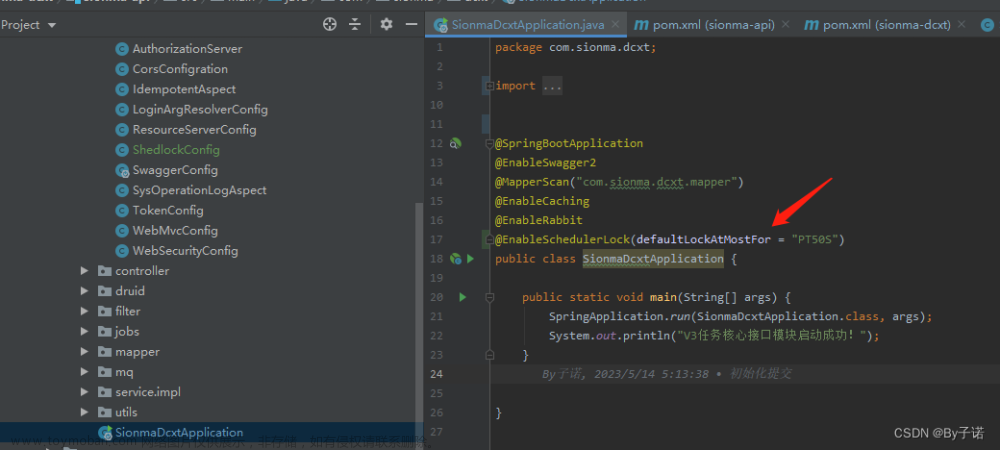-
ScheduledThreadPoolExecutor
- 一、概述
-
二、常用方法
- 1、schedule 方法
- 2、scheduleAtFixedRate方法
- 3.scheduleWithFixedDelay方法
- 三、ScheduledExecutorService的创建方式
ScheduledThreadPoolExecutor
一、概述
java 中ScheduledExecutorService接口是基于线程池设计的定时任务类,每个调度任务都会分配到线程池中的一个线程去执行,也就是说,任务是并发执行,互不影响。
其中的一个实现类是ScheduledThreadPoolExecutor
(1)>ScheduledThreadPoolExecutor实现ScheduledExecutorService接口,实现了一些定时任务处理的方法。
(2)>ScheduledThreadPoolExecutor继承了ThreadPoolExecutor,可以通过线程池进行任务的管理和调度。
二、常用方法
1、schedule 方法
该方法的作用是提交一个延迟执行的任务,任务从提交时间算起延迟单位unit的deplay时间后执行,提交的不是周期任务,任务只会执行一次
ScheduledFuture<?> schedule(Runnable var1, long period, TimeUnit var4);
ScheduledFuture<V> schedule(Callable<V> var1, long var2, TimeUnit var4);
参数解析:
- Runnable 需要运行的任务
- period 间隔时间
- unit参数是时间单元
代码demo:
ScheduledExecutorService service = new ScheduledThreadPoolExecutor(1);
System.out.println("当前时间为:" + LocalDateTime.now().format(DateTimeFormatter.ofPattern("yyyy-MM-dd HH:mm:ss")));
// 使用的Runnable 匿名函数编写的
service.schedule(() -> {
System.out.println("我是使用schedule方法执行");
Thread thread = Thread.currentThread();
System.out.println("我是间隔1s执行的任务,线程名称为:" + thread.getName() + ",线程ID为:" + thread.getId() + ",当前时间:" + LocalDateTime.now().format(DateTimeFormatter.ofPattern("yyyy-MM-dd HH:mm:ss")));
}, 1, TimeUnit.SECONDS); // 延1秒后开始执行
ScheduledExecutorService service = new ScheduledThreadPoolExecutor(1);
System.out.println("当前时间为:" + LocalDateTime.now().format(DateTimeFormatter.ofPattern("yyyy-MM-dd HH:mm:ss")));
service.schedule(new Runnable() {
@Override
public void run() {
System.out.println("我是使用schedule方法执行");
Thread thread = Thread.currentThread();
System.out.println("我是间隔1s执行的任务,线程名称为:" + thread.getName() + ",线程ID为:" + thread.getId() + ",当前时间:" + LocalDateTime.now().format(DateTimeFormatter.ofPattern("yyyy-MM-dd HH:mm:ss")));
}
}, 1, TimeUnit.SECONDS); // 延1秒后开始执行
ScheduledExecutorService service = new ScheduledThreadPoolExecutor(1);
//使用 Callable 实现,该实现有返回值,可以接收返回的数据
ScheduledFuture<Object> future = service.schedule(new Callable<Object>() {
@Override
public Object call() throws Exception {
System.out.println("我是使用schedule方法执行");
Thread thread = Thread.currentThread();
System.out.println("我是间隔1s执行的任务,线程名称为:" + thread.getName() + ",线程ID为:" + thread.getId() + ",当前时间:" + LocalDateTime.now().format(DateTimeFormatter.ofPattern("yyyy-MM-dd HH:mm:ss")));
return null;
}
}, 1, TimeUnit.SECONDS);// 延1秒后开始执行
Object o = future.get();
System.out.println(o);
输出结果为:
当前时间为:2024-03-18 14:31:01
我是使用schedule方法执行
我是间隔1s执行的任务,线程名称为:pool-1-thread-1,线程ID为:21,当前时间:2024-03-18 14:31:02
2、scheduleAtFixedRate方法
该方法相对起始时间点以固定频率调用指定的任务(fixed-rate任务)。当把任务提交到线程池并延迟initialDelay时间后开始执行任务command。然后从initialDelay+period时间点再次执行,而后在initialDelay+2*period时间点再次执行,循环往复,直到抛出异常或者调用了任务的cancel方法取消了任务,或者关闭了线程池。
参数讲解:
- command 任务实例
- initialDelay参数是初始化延迟时间
- period参数是间隔时间
- unit参数是时间单元
public ScheduledFuture<?> scheduleAtFixedRate(Runnable command, long initialDelay, long period, TimeUnit unit)
(1):当任务实例commod执行的时间小于延迟间隔时间delay情况
ScheduledExecutorService scheduledExecutorService = new ScheduledThreadPoolExecutor(1);
System.out.println("当前时间为:" + LocalDateTime.now().format(DateTimeFormatter.ofPattern("yyyy-MM-dd HH:mm:ss")));
scheduledExecutorService.scheduleAtFixedRate(new Runnable() {
@Override
public void run() {
System.out.println("开始测试,当前时间为:" + LocalDateTime.now().format(DateTimeFormatter.ofPattern("yyyy-MM-dd HH:mm:ss")));
try {
TimeUnit.SECONDS.sleep(3);
} catch (InterruptedException e) {
throw new RuntimeException(e);
}
System.out.println("结束测试,当前时间为:" + LocalDateTime.now().format(DateTimeFormatter.ofPattern("yyyy-MM-dd HH:mm:ss")));
}
}, 5, 5, TimeUnit.SECONDS); // 延迟5秒后执行,每隔3秒执行一次
执行结果为:
当前时间为:2024-03-18 15:15:06
开始测试,当前时间为:2024-03-18 15:15:11
结束测试,当前时间为:2024-03-18 15:15:14
#第二次执行时间是第一次时间 + period 即11 + 5 = 16;
开始测试,当前时间为:2024-03-18 15:15:16
结束测试,当前时间为:2024-03-18 15:15:19
(2):当任务实例commod执行的时间大于间隔时间period情况
修改 TimeUnit.SECONDS.sleep(3); 为 TimeUnit.SECONDS.sleep(6);,执行查看运行结果!
执行结果为:
当前时间为:2024-03-18 15:19:57
开始测试,当前时间为:2024-03-18 15:20:02
结束测试,当前时间为:2024-03-18 15:20:08
开始测试,当前时间为:2024-03-18 15:20:09
结束测试,当前时间为:2024-03-18 15:20:15
总结
ScheduleAtFixedRate 每次执行时间为上一次任务开始起向后推一个时间间隔。分为两种情况:
(1)若command执行的时间小于period若每次执行时间为 :initialDelay, initialDelay+period, initialDelay+2period, …;
(2)若command执行的时间大于period,则command执行完,下一次任务将立即执行!下即下一次任务不会按照预期的时间间隔执行,每次执行时间为 :initialDelay, initialDelay+taskExecutorTIme, initialDelay+2*taskExecutorTIme, …;
taskExecutorTIme为任务执行的时间!
3.scheduleWithFixedDelay方法
该方法的作用是,当任务执行完毕后,让其延迟固定时间后再次运行(fixed-delay任务)。其中initialDelay表示提交任务后延迟多少时间开始执行任务command,delay表示当任务执行完毕后延长多少时间后再次运行command任务,unit是initialDelay和delay的时间单位。任务会一直重复运行直到任务中抛出了异常,被取消了,或者关闭了线程池。
参数:
- command参数是任务实例,
- initialDelay参数是初始换延迟时间,
- delay参数是延迟间隔时间,
- unit参数是时间单元
public ScheduledFuture<?> scheduleWithFixedDelay(Runnable command, long initialDelay, long delay, TimeUnit unit)
(1):当任务实例commod执行的时间小于延迟间隔时间delay情况
ScheduledExecutorService scheduledExecutorService = new ScheduledThreadPoolExecutor(1);
System.out.println("当前时间为:" + LocalDateTime.now().format(DateTimeFormatter.ofPattern("yyyy-MM-dd HH:mm:ss")));
scheduledExecutorService.scheduleWithFixedDelay(new Runnable() {
@Override
public void run() {
System.out.println("开始测试,当前时间为:" + LocalDateTime.now().format(DateTimeFormatter.ofPattern("yyyy-MM-dd HH:mm:ss")));
try {
TimeUnit.SECONDS.sleep(1);
} catch (InterruptedException e) {
throw new RuntimeException(e);
}
System.out.println("结束测试,当前时间为:" + LocalDateTime.now().format(DateTimeFormatter.ofPattern("yyyy-MM-dd HH:mm:ss")));
}
}, 5, 3, TimeUnit.SECONDS); // 延迟5秒后执行,每隔3秒执行一次
执行结果:
当前时间为:2024-03-18 15:34:23
开始测试,当前时间为:2024-03-18 15:34:28
结束测试,当前时间为:2024-03-18 15:34:29
#第二次执行的时间 == 第一次任务开始时间+任务处理时间+delay延迟时间
#即 32 == 28 + 3秒 + 3秒
开始测试,当前时间为:2024-03-18 15:34:32
结束测试,当前时间为:2024-03-18 15:34:33
(2):当任务实例commod执行的时间大于延迟间隔时间delay情况
修改 TimeUnit.SECONDS.sleep(3); 为 TimeUnit.SECONDS.sleep(6);,执行查看运行结果!
当前时间为:2024-03-18 15:38:28
开始测试,当前时间为:2024-03-18 15:38:33
结束测试,当前时间为:2024-03-18 15:38:39
#第二次任务执行开始时间 == 第一次任务执行开始时间 + 任务处理的时间 + delay延迟时间
#即 42 == 33 + 6 + 3
开始测试,当前时间为:2024-03-18 15:38:42
结束测试,当前时间为:2024-03-18 15:38:48
3:总结
不管任务command执行的时间是多长,下一次任务的执行时间都是上一次任务执行完后在等待延迟间隔delay时间后执行下一次任务。
ScheduleWithFixedDelay 每次执行时间为上一次任务结束起向后推一个时间间隔,即每次执行时间为:initialDelay, initialDelay+executeTime+delay, initialDelay+2executeTime+2delay
三、ScheduledExecutorService的创建方式
public static void classCreate() {
// 方式一
ScheduledExecutorService scheduledExecutorService = new ScheduledThreadPoolExecutor(1);
// 方式二,方式二和方式一可以等价
ScheduledExecutorService scheduledExecutorService1 = Executors.newScheduledThreadPool(1);
}
参考地址:文章来源:https://www.toymoban.com/news/detail-841218.html
https://www.cnblogs.com/xuwc/p/14053613.html文章来源地址https://www.toymoban.com/news/detail-841218.html
到了这里,关于ScheduledThreadPoolExecutor 定时任务的文章就介绍完了。如果您还想了解更多内容,请在右上角搜索TOY模板网以前的文章或继续浏览下面的相关文章,希望大家以后多多支持TOY模板网!












